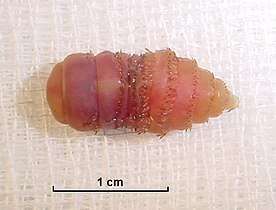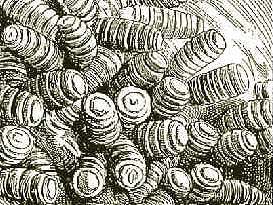Gasterophilus
The Gasterophilus, commonly known as botfly, is a parasitic fly from the family Oestridae that affects different types of animals, especially horses, but it can also act on cows, sheep, goats and, even, it has been recorded a case in a human baby.[1]
| Gasterophilus | |
|---|---|
.jpg) | |
| G. intestinalis | |
| Scientific classification | |
| Kingdom: | Animalia |
| Phylum: | Arthropoda |
| Class: | Insecta |
| Order: | Diptera |
| Family: | Oestridae |
| Subfamily: | Gasterophilinae |
| Genus: | Gasterophilus Leach, 1817 |
| Species | |
| |
| Synonyms | |
|
Gastrus Meigen, 1824 | |
This parasite affects the animal gastrointestinal tract not with the finality of feed themselves because the adults don’t have functional mouthparts and are unable to eat in their whole life,[2] but to give to their offspring an alimentary source.
Although not deadly, due to the usual low larva population that infests the animal, large larva populations can cause health issues to the host. For example, a typical horse can tolerate a hundred larvae withot any effects.
Species
There are six species of Gasterophilus:
- G. haemorrhoidalis (lip botfly) – ranges worldwide and primarily infects horses, mules, donkey and reindeer
- G. inermis – an Old World species that infects horses, donkeys and zebra
- G. intestinalis (horse botfly) – ranges worldwide and primarily infects horses, mules and donkeys
- G. nasalis (throat botfly) – especially Holarctic but ranges worldwide, primarily infects sheep, goats, horses, donkeys, zebra and sometimes cattle
- G. nigricornis (broad-bellied horse bot) – ranges from the Middle East to China, infects duodenum of horses and donkeys
- G. pecorum (dark-winged horse bot) – the most pathogenic species in the genus. Ranges through the Old World and infects the mouth, tongue, esophagus and stomach of horses, donkeys and zebras
Taxonomy
Larva
In the third larval stage, the larvae have a length that can go from 1.27cm to 1.91 cm. They have a hooked mouthpart that allows them to attached into the gastrointestinal tract of the infected animal and a rounded body that is covered with spines rows, which quantity varies from different species.
After this stage, the larva is excreted with the animal feces in the form of a pupa.[3][4]
Adult
The adults have a length that can be between 1.67 and 1.91 cm. During this phase they look similar to drone bumble bees, they have developed a pair of wings with brown patches and a body that is covered with yellow and black hairs.
Although they have non-functional mouthparts, the reason why they are unable to feed themselves[3].[4]
Looking into the different species G. haemorrhoidalis and G. nasalis can be identified because they have two rows of spikes on the ventral surface of the larval segments and G. intestinalis, for another side, has mouthparts that are not uniformly curved dorsally and the body spikes present have blunt-ended tips.
Life cycle
The first stage: During the summer months, the full-grown Gasterophilus laid them eggs over the hair, face, and extremities of their future host (these eggs are laid on different portions of the body according to the various Gasterophilus species). Due to the animal grooming that starts after seven days from its laid[5], the hatched larvae end up in the host mouth and tongue where they get attached for more than a month before being ingested.
During this process, the animal can suffer from inflammation of the oral mucosa.
The second stage: In this stage, the larvae have been ingested and now there are in the gastrointestinal tract of the host where they attached, once more. Here they mature and stay from eight to nine months to pass the winter and being released in spring. During this phase, the infection can produce in the host gastritis, ulceration, even perforations in the walls of the tract in severe cases and much more.
The third stage: The larvae are mature enough so they developed its pupa and once finished there are released with the animal feces during spring. Once in the outside, after 3-10 weeks (depending on the temperature)[5] the adult bolt flies emerged from the pupa and start the cycle again.
Treatment
The most efficient way known to avoid the infection of Gasterophilus is by parasitizing the animals with products like trichlorphon and dichlorvos, by scratching and cleaning with hot water the places where the eggs are laid with the finality of hatch them and kill the larvae and by cleaning the areas where the feces of the infected animal had been with the finality of avoiding the adult formation.[6]
Gallery
- G. intestinalis eggs on a horse
- G. intestinalis eggs on a horse (closer)
 G. intestinalis larva
G. intestinalis larva Drawing of G. intestinalis larvae in a horse's stomach
Drawing of G. intestinalis larvae in a horse's stomach- G. intestinalis adult female
References
- Royce, L. A.; Rossignol, P. A.; Kubitz, M. L.; Burton, F. R. (1999-03-01). "Recovery of a second instar Gasterophilus larva in a human infant: a case report". The American Journal of Tropical Medicine and Hygiene. 60 (3): 403–404. doi:10.4269/ajtmh.1999.60.403. ISSN 0002-9637.
- "Bot Flies | Livestock Veterinary Entomology". livestockvetento.tamu.edu. Retrieved 2019-12-07.
- Marchiondo, Alan A.; Cruthers, Larry R.; Fourie, Josephus J. (2019-06-08). Parasiticide Screening: Volume 1: In Vitro and In Vivo Tests with Relevant Parasite Rearing and Host Infection/Infestation Methods. Academic Press. ISBN 978-0-12-813891-5.
- "horse bot fly - Gasterophilus intestinalis (DeGeer)". entnemdept.ufl.edu. Retrieved 2019-12-07.
- Elsheikha, Hany M.; Khan, Naveed Ahmed (2011). Essentials of Veterinary Parasitology. Horizon Scientific Press. ISBN 978-1-904455-79-0.
- "horse bot fly - Gasterophilus intestinalis (DeGeer)". entnemdept.ufl.edu. Retrieved 2019-12-07.
External links
| Wikimedia Commons has media related to Gasterophilus. |
![]()